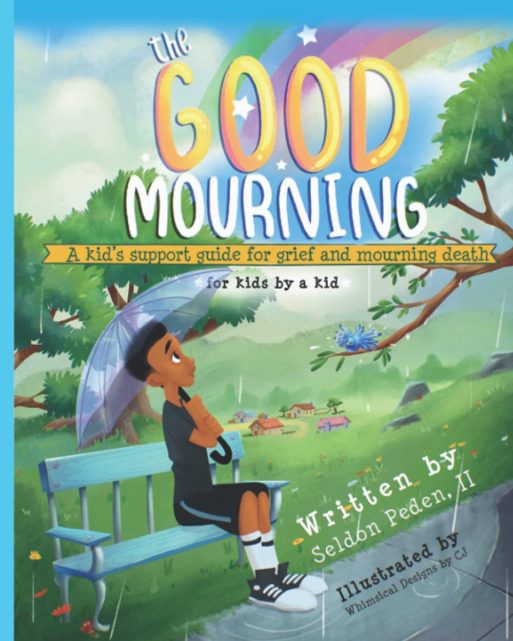
“The Good Mourning “by Seldon Peden II
Credit: Amazon
An estimated 6 million children ages 0-17 in the U.S.A will have a parent or sibling die. While there are numerous picture books for children themed around grief or processing death, most of these are written by adults. It’s rare to find a child writing about grief for other children, but that’s exactly what Sheldon Peden II accomplishes in his book, “The Good Mourning.” Marketed as “a kid’s support guide for grief and mourning death,” Peden speaks from his own experience to offer reassurance that kids will be able to move through their grief.
Sheldon Peden II was only 4 years old when his mother Cathy died of cancer. Peden writes in “The Good Mourning” about his family and remembering the day his dad told him that his mom had died: “I cried… and cried… and cried… [My dad and I] laid on the couch and he just held me until I had run out of tears for the day. I didn’t know what else to do, but neither did my dad. Just like that, I was gloomier than I had ever been in my life.”
Now 11 years old, Peden reflects on what his grief was like, and hopes to connect with other grieving children. Peden shares his emotional pain, but also a promise to the reader that, just like he did, they too will eventually work through the pain and be able to smile, enjoy good memories of their loved one, and do things that they know would make their loved one proud. Peden labels this the “good mourning” that titles his book, and shares that, just like morning follows night, a “good mourning” can follow grief.

Sheldon Peden II
In easily accessible language, Peden offers a definition of words like “cemetery,” and “pass away,” and also describes the range of emotional reactions that people can have to pain and grief. His book is composed of 26 pages and written in language appropriate for children ages 7-12. Aided by animated illustrations, Peden offers simple reassurance that his fellow grieving children can reach a point of incorporating their grief into their life in helpful ways.
The book ends with a list of 18 things that Peden did to reach his own “good mourning,” including advice such as “Start a new tradition in their name,” and “Make TikTok videos dedicated to your loved one.” The only flaw in the book is that it could have been helpful for Peden to share more stories in detail about these various activities he did, or perhaps incorporate pages at the end of the book for young readers to brainstorm their own activities.
Overall, “The Good Mourning” can be a valuable resource for grieving children. The strongest section in the book comes when Peden reflects on how adults react to grief and want to prevent children from feeling sad. Peden shares three lessons he learned: “Adults don’t know all the answers. Adults don’t tell kids some things because they believe it will hurt us or we won’t understand; and they want to protect us from sadness…. My dad didn’t know how strong I was, and he didn’t know how much I already knew and could handle.” Although Peden’s audience is clearly his young peers, he also offers a wise reminder to adults that kids pick up on much more than we give them credit for, and we cannot shield a bereaved child from grief by not talking about it with them.

 “The Good Mourning” by Seldon Peden II
“The Good Mourning” by Seldon Peden II


 The Other Death in the Family
The Other Death in the Family

 The Healing Sound of Singing Bowls
The Healing Sound of Singing Bowls














